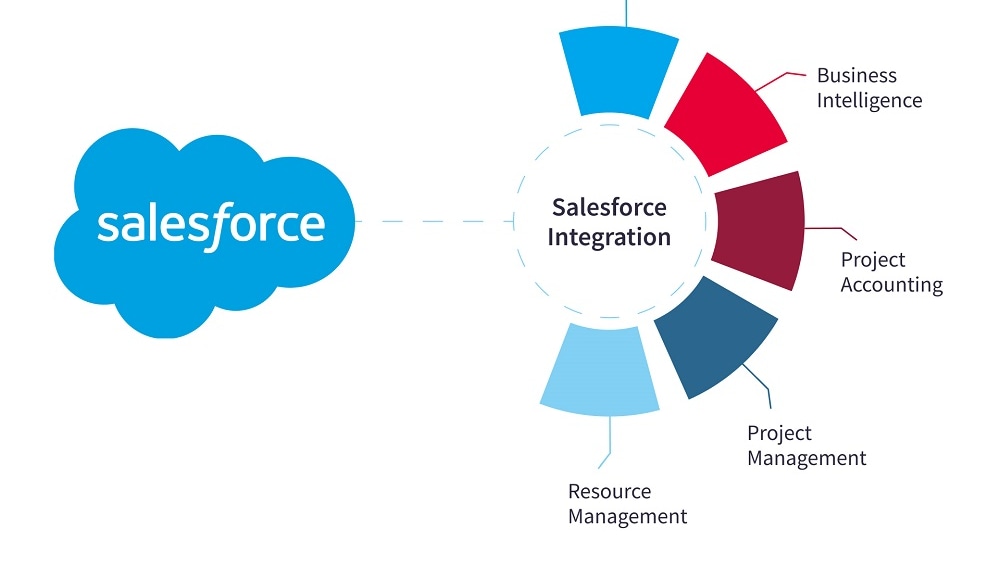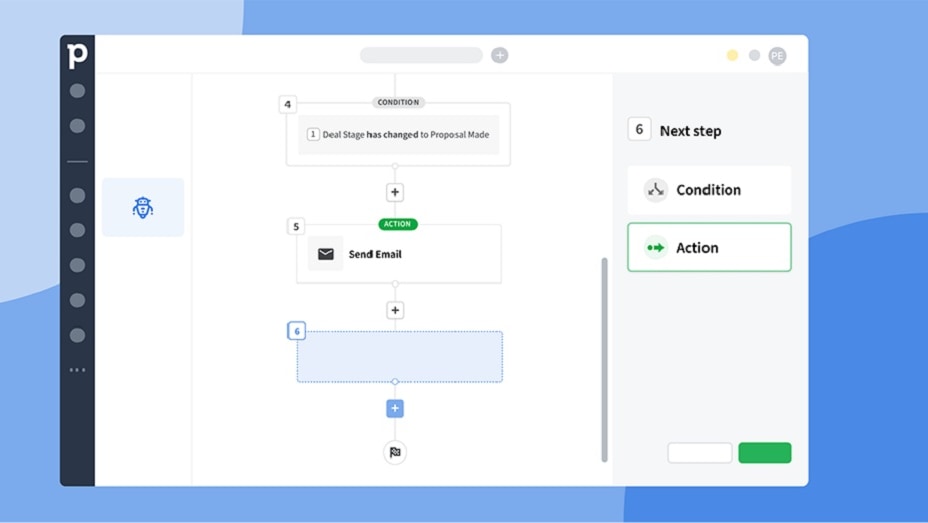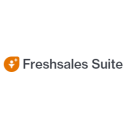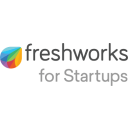Pipedrive vs Salesforce: How to choose the right tool for your business
- 01Pipedrive vs Salesforce: overview
- 02What's the difference between Pipedrive and Salesforce?
- 03Pipedrive pros and cons
- 04Salesforce pros and cons
- 05Pipedrive compared to Salesforce
- 06Salesforce compared to Pipedrive
- 07Features comparison
- 08Pipedrive vs Salesforce: Which is the best for your business?
- 09Promotions on Prospecting software
- 10Alternatives to Pipedrive & Salesforce
Save up to $4,644 on Pipedrive
Pipedrive
30% off for 12 months
Save up to $4,644 on Pipedrive
Pipedrive
30% off for 12 months
Customer relationship management (CRM) software is vital for your business, ensuring your sales team always has the most up-to-date customer data at their fingertips. This information improves lead management and optimizes your sales pipeline, boosting revenue. However, the array of CRM options available to businesses can make choosing the right one a daunting task.
In this article, we take an in-depth look at two choices of CRM software—Pipedrive vs Salesforce. After reading it, you’ll better understand their key features, pros, and cons so you can make an informed decision as to the best one for your needs.
Pipedrive vs Salesforce: overview
In the world of customer relationship management (CRM) systems, Pipedrive and Salesforce emerge as formidable contenders, each with its unique strengths and capabilities tailored to diverse user requirements.
Pipedrive is celebrated for its user-friendly interface and simplicity in managing sales pipelines. It provides an intuitive platform that empowers sales teams to effortlessly track leads, manage contacts, and streamline their sales processes. In contrast, Salesforce offers an extensive array of features, encompassing sales automation, analytics, marketing, and customer service functionalities. It caters to businesses of all sizes, accommodating the complex needs of enterprises while remaining adaptable for startups.
Now, let's delve into the Pipedrive vs. Salesforce comparison to guide you in making a well-informed decision when selecting the ideal CRM system that aligns with your specific business needs.
What's the difference between Pipedrive and Salesforce?


Pipedrive and Salesforce’s CRM platforms are well-respected in the industry, offering contact and lead management, sales pipeline tracking, and AI features to track and optimize contacts. However, the critical difference between the two platforms lies in the depth of their feature sets. Salesforce stands out as a versatile, scalable CRM software. It includes various advanced features, including opportunity management, advanced forecasting, and rule-based lead scoring. Plus, its high-level automation options, covering approvals and complex workflows, make it ideal for scaling teams. Salesforce’s CRM integrates with a range of third-party apps and other Salesforce solutions, spanning customer service, marketing, and commerce. This makes it a highly adaptable software you can fully customize to your business’s needs.
This versatility, however, comes with a higher price tag and a steeper initial learning curve. Compared to Salesforce, Pipedrive offers a more budget-friendly alternative with a narrower yet functional feature set. Its user-friendly interface caters to sales teams with varying levels of technical expertise. Pipedrive, as the name suggests, emphasizes pipeline management. It offers a visual representation of the sales process to record and manage customer details and interactions easily. It provides additional functionality beyond this with add-ons for marketing and customer service. Due to its simplicity, cost, and functional feature set, Pipedrive is popular for small to medium-sized businesses.
The platforms’ scope of features also results in distinct user interfaces. Pipedrive boasts a modern and intuitive interface, with features thoughtfully organized to make it quick to locate them. With a minimal learning curve, your sales team can hit the ground running from day one. Some users may find Salesforce’s user interface a little dated in appearance and more challenging to navigate, primarily due to its extensive feature set. While this initial complexity may feel overwhelming, it rewards users with access to more advanced features.
20% off for 12 months on Pipedrive
Get 20% off for 12 months on Pipedrive and up to $2,376 savings with Secret.
Pipedrive pros and cons
What are the advantages of Pipedrive?
- Intuitive interface: Pipedrive's user-friendly interface is one of its standout features. It's easy to navigate, making it accessible to both experienced CRM users and newcomers.
- Sales pipeline management: Pipedrive excels at visualizing and managing sales pipelines. It allows users to track leads, deals, and contacts through various stages, providing a clear overview of the sales process.
- Customization: Pipedrive offers extensive customization options. Users can tailor their pipelines, fields, and workflows to match their specific sales processes and business needs.
- Email integration: Seamless email integration enables users to send and receive emails directly within the platform. This feature helps in tracking communication history and staying organized.
- Mobile accessibility: Pipedrive offers mobile apps for iOS and Android devices, allowing sales teams to access critical information and manage leads while on the go.
What are the disadvantages of Pipedrive?
- Limited marketing features: Pipedrive primarily focuses on sales management and lacks robust marketing automation capabilities compared to some competitors.
- Steep learning curve for advanced features: While the basic features are user-friendly, mastering more advanced capabilities may require time and training.
- Limited reporting and analytics: Some users find the reporting and analytics features in Pipedrive to be less comprehensive than those of other CRM systems.
- Cost: Depending on the features and users needed, Pipedrive can be relatively expensive for smaller businesses.
- Integration limitations: Although it offers integrations with popular tools, Pipedrive may not support all the specialized apps and services that businesses require, which can limit its versatility.
Compare Pipedrive to other tools
Salesforce pros and cons
What are the advantages of Salesforce?
- Comprehensive CRM: Salesforce is a robust and feature-rich CRM platform that offers a wide range of tools for sales, marketing, customer service, and analytics. It can accommodate the needs of businesses of all sizes.
- Scalability: Salesforce scales effectively, making it suitable for both small businesses and large enterprises. It can adapt to your organization's growth.
- Customization: Salesforce provides extensive customization options, allowing businesses to tailor the CRM to their specific processes and requirements.
- Integration capabilities: Salesforce offers a vast ecosystem of third-party integrations, enabling seamless connections with other tools and systems, such as email, marketing automation, and e-commerce platforms.
- Advanced analytics and reporting: Salesforce offers robust analytics and reporting tools, providing valuable insights into customer data, sales performance, and marketing campaigns.
What are the disadvantages of Salesforce?
- Complexity: Salesforce's comprehensive feature set can be overwhelming for new users. It may require significant training and configuration to use effectively.
- Cost: Salesforce is known for its pricing, which can be relatively high, especially for small businesses. The cost may increase as you add more features or users.
- Steep learning curve: Due to its complexity, mastering Salesforce can take time, and users may find it challenging to navigate the platform initially.
- Resource-intensive implementation: Implementing Salesforce can be resource-intensive in terms of time, IT expertise, and financial investment.
- Limited customer support: Some users have reported challenges with Salesforce's customer support, particularly for smaller organizations or those on lower-tier plans. Access to support may vary depending on your subscription level.
Compare Salesforce to other tools
Pipedrive compared to Salesforce
When comparing Pipedrive and Salesforce, Pipedrive sets itself apart with its emphasis on simplicity and streamlined sales pipeline management. It caters to users who seek an intuitive CRM platform that offers a clear and easy-to-use interface for managing leads and deals. Pipedrive's pricing structure, which provides flexibility and transparent pricing tiers, is especially appealing to businesses looking for straightforward and cost-effective CRM solutions.
While both Pipedrive and Salesforce are robust CRM platforms, the choice between them depends on your specific requirements. Pipedrive offers a user-friendly and straightforward solution with a focus on sales pipeline management, making it an excellent choice for those who prioritize ease of use and efficiency in their sales processes.
Is Pipedrive better than Salesforce?
Determining whether Pipedrive is better than Salesforce hinges on your unique CRM requirements. Pipedrive shines as an ideal choice for users who prioritize simplicity and streamlined sales pipeline management. Its intuitive interface and focus on ease of use make it an appealing option for those who want efficient lead and deal management without extensive training.
Conversely, Salesforce offers a comprehensive CRM platform with extensive features, a wide array of integrations, robust automation capabilities, and in-depth reporting and analytics. It caters to businesses seeking advanced CRM functionalities, seamless integration with various tools, and sophisticated data analysis for comprehensive customer relationship management.
What is Pipedrive best used for?
Pipedrive is primarily tailored for efficient and streamlined sales pipeline management. It excels in simplifying the process of managing leads, deals, and contacts, making it an ideal choice for businesses and sales teams who prioritize effective sales processes and organization.
With its intuitive interface and customizable features, Pipedrive empowers users to keep their sales pipelines organized and easily accessible. It's best used when you want to enhance your sales team's efficiency, track leads and deals accurately, and maintain a clear overview of your sales processes. Pipedrive is particularly valuable when your focus is on optimizing your sales efforts and achieving better control and visibility over your sales pipeline.
Can Pipedrive replace Salesforce?
Whether Pipedrive can fully replace Salesforce depends on your specific CRM requirements and the scale of your organization. Pipedrive offers a user-friendly and streamlined approach to sales pipeline management, making it a strong choice for businesses looking to simplify their sales processes and increase efficiency.
Pipedrive excels in lead and deal management, providing an intuitive interface and customization options. If your primary focus is on straightforward sales pipeline management and you value ease of use, Pipedrive can be a compelling alternative to Salesforce.
While Pipedrive can be an excellent solution for many businesses seeking streamlined CRM, it may not entirely replace Salesforce for organizations with more extensive CRM requirements and a reliance on advanced features and integrations. The choice between the two should align with your specific CRM needs and organizational scale.
Is Pipedrive cheaper than Salesforce?
When it comes to comparing the pricing of Pipedrive and Salesforce, there are significant differences worth noting. Pipedrive’s pricing structure is typically more straightforward and transparent. It provides various pricing tiers, each with its features, and users are charged on a per-user, per-month basis. This simplicity can be cost-effective for businesses with straightforward CRM needs, as you only pay for the number of users you require.
On the other hand, Salesforce's pricing tends to be higher than Pipedrive, particularly for larger enterprises or businesses needing advanced CRM capabilities. Pipedrive often stands out as a more cost-effective option for businesses seeking a simpler, user-based pricing model, while Salesforce's pricing can vary significantly depending on your specific CRM requirements and the size of your organization.
Is there a better Prospecting software than Pipedrive?
Pipedrive is undoubtedly a robust CRM solution, but it's essential to assess whether there might be a better-fit CRM software for your specific requirements and business needs.
Several noteworthy alternatives to Pipedrive in the CRM space include Salesforce, HubSpot CRM, Zoho CRM, and Insightly.
The choice of CRM software hinges on your organization's unique sales and customer management goals, team size, and feature preferences. While Pipedrive excels in its simplicity and sales pipeline management, other CRM platforms may offer more extensive functionalities, integrations, or analytics that align more closely with your CRM strategy and objectives.
30% off for 12 months on Pipedrive
Get 30% off for 12 months on Pipedrive and up to $4,644 savings with Secret.
Salesforce compared to Pipedrive
Salesforce distinguishes itself with its expansive array of CRM capabilities, positioning it as a formidable choice for businesses seeking a comprehensive and versatile CRM platform. Salesforce's pricing structure offers various editions, each tailored to different organizational needs and budgets, accommodating users with diverse CRM requirements.
While both Salesforce and Pipedrive excel in CRM functionality, the choice between the two depends on your specific needs. Salesforce delivers an extensive and flexible solution for businesses looking to streamline sales, marketing, customer service, and analytics under one platform. It provides advanced automation, robust integrations, and comprehensive reporting and analytics, making it an excellent choice for organizations seeking a holistic CRM solution to optimize their customer relationships and processes.
Is Salesforce better than Pipedrive?
The determination of whether Salesforce is superior to Pipedrive depends on your specific CRM requirements and organizational goals. Salesforce offers a wide spectrum of CRM features and functionalities, making it a formidable choice for businesses seeking a comprehensive CRM solution. If your organization requires advanced automation, extensive integrations with other software tools, and in-depth analytics to optimize customer relationships and processes, Salesforce may prove to be the superior option.
However, it's crucial to acknowledge that Pipedrive has its unique strengths, particularly in simplicity, ease of use, and streamlined sales pipeline management. If your primary focus is on efficient lead and deal management with a user-friendly interface, Pipedrive remains a compelling choice that aligns with those priorities.
What is Salesforce best used for?
Salesforce is a versatile customer relationship management (CRM) platform primarily designed for businesses aiming to enhance their customer relationships and sales processes. It excels in automating and optimizing various aspects of customer management and engagement. Salesforce is best used for managing leads, tracking sales opportunities, and nurturing customer relationships. It offers a wide range of features for sales, marketing, customer service, and analytics.
Moreover, Salesforce's robust integrations and customization options make it suitable for businesses of all sizes and industries, allowing them to tailor the CRM to their specific needs. Whether you're a small startup or a large enterprise, Salesforce provides the tools and flexibility to optimize your customer relationships and sales processes.
Can Salesforce replace Pipedrive?
The question of whether Salesforce can effectively replace Pipedrive depends on your specific CRM requirements and organizational objectives.
Salesforce is a robust CRM platform known for its comprehensive capabilities, including sales automation, marketing, customer service, and analytics. It is suitable for businesses seeking a holistic CRM solution that covers various aspects of customer management and engagement. If your organization requires advanced automation, extensive integrations, and in-depth analytics to optimize your customer relationships and processes, Salesforce may serve as a viable replacement for Pipedrive.
However, it's important to consider that Pipedrive has its unique strengths, particularly in its simplicity, user-friendliness, and streamlined sales pipeline management. If your primary focus is on efficient lead and deal management with a straightforward interface, Pipedrive may remain the preferred choice.
Is Salesforce cheaper than Pipedrive?
When it comes to comparing the cost of Salesforce and Pipedrive, there are several factors to consider. Salesforce typically offers a range of editions and pricing tiers, which can cater to various organizational needs and budgets. However, it's essential to note that Salesforce's pricing can become more complex as you scale up or add more functionalities, potentially leading to higher costs.
Pipedrive, on the other hand, often provides a more straightforward and transparent pricing structure. For smaller organizations or those with straightforward CRM needs, Pipedrive's pricing model can be cost-effective. The cost-effectiveness of Salesforce versus Pipedrive depends on your specific CRM requirements, the size of your organization, and your budget considerations.
Is there a better CRM software than Salesforce?
Salesforce is a renowned and comprehensive CRM platform, but it's essential to assess whether there might be a more tailored solution for your specific CRM requirements and organizational objectives.
Several noteworthy alternatives to Salesforce in the CRM space include Pipedrive, Freshworks, HubSpot CRM, Zoho CRM, and Insightly.
The choice of CRM software hinges on your unique CRM goals, team size, budget considerations, and feature preferences. While Salesforce offers an extensive array of CRM capabilities, other CRM platforms may cater better to your specific CRM strategy and objectives.
Features comparison
Pipedrive’s User-Friendly Approach Excels Over Salesforce

When it comes to CRM tools, the ease of use can be a deciding factor. Pipedrive shines in this regard with its intuitive interface tailored for sales teams. Its simplicity makes it accessible even for beginners, ensuring a hassle-free experience. Pipedrive effectively organizes features, presenting information clearly, which is a boon for small businesses and startups seeking a straightforward yet potent CRM solution.
For instance, Pipedrive streamlines lead management, making it easy to track interactions and deals. The interface provides a clear overview of sales pipelines, simplifying the sales process.
In contrast, Salesforce, renowned for its extensive features, may appear daunting to newcomers. Its sheer scope can lead to complexity, making it better suited for larger enterprises or those with dedicated IT teams who can fully leverage its capabilities.
Salesforce’s App Integration Capabilities Dominate Over Pipedrive

Integration capabilities can significantly impact a CRM's effectiveness. Pipedrive and Salesforce excel in this area, albeit in different ways.
Pipedrive shines in seamlessly integrating with common software tools, catering primarily to small businesses. For example, Pipedrive effortlessly connects with Google Apps, MailChimp, Zapier, and Slack, providing a plug-and-play solution for streamlined operations. This versatility suits startups and small enterprises, enhancing efficiency and connectivity with essential applications.
In contrast, Salesforce dominates in integration capabilities on a large scale. Salesforce's AppExchange stands as one of the most comprehensive business app marketplaces, offering an extensive array of integration possibilities. This depth of integration is particularly valuable for larger enterprises with complex requirements. Salesforce connects seamlessly with numerous enterprise software providers, cementing its position as a powerhouse in integration capabilities. For example, Salesforce can integrate with ERP systems, marketing automation platforms, and advanced analytics tools, enabling enterprises to create interconnected ecosystems.
Salesforce’s Centralized Lead Management Triumphs Over Pipedrive

While both Pipedrive and Salesforce offer lead management capabilities, Salesforce stands out with its ability to centralize crucial contact and account information effortlessly. This centralized approach simplifies access to vital data and streamlines lead management.
For instance, Salesforce allows users to consolidate contact and account information within a few clicks, creating a unified view of each lead or customer. This feature enhances user efficiency and ensures that all relevant data is readily available. Furthermore, Salesforce's automatic contact synchronization from email inboxes simplifies lead management even further. It seamlessly integrates with email services, such as Gmail and Outlook, to keep contact information up to date and easily accessible.
In summary, Salesforce's centralized lead management and email synchronization capabilities provide users with a comprehensive and efficient solution for lead tracking and customer relationship management. While Pipedrive is effective, Salesforce's additional features make it a powerful choice for organizations seeking a robust CRM system.
Both Pipedrive and Salesforce Equally Excel in Reporting and Analytics

Pipedrive and Salesforce stand shoulder to shoulder when it comes to robust reporting and analytics capabilities, empowering businesses with valuable insights.
Pipedrive offers customizable reports and interactive dashboards that allow users to dive deep into their data, creating tailored views of performance metrics. For example, you can generate reports on lead conversion rates or sales pipeline progression.
On the other hand, Salesforce provides pre-built and customizable dashboards and reports, enabling users to monitor sales progress against objectives. For instance, you can track opportunities won by region or analyze customer satisfaction trends.
Both tools illuminate critical aspects of business performance, unveiling bottlenecks and offering visual representations of results. Whether you opt for Pipedrive's customized approach or Salesforce's pre-built solutions, both platforms deliver invaluable insights.
Pipedrive is Superior in Offering Personalized Deal Pages than Salesforce

Pipedrive stands out from Salesforce by offering personalized deal pages for every prospect, a feature that streamlines the sharing of relevant information and updates throughout the sales process. This level of personalization creates a more tailored approach to lead management, which is currently not available in Salesforce.
For instance, with Pipedrive, businesses can custom-create deal pages, ensuring that each prospect receives information and updates aligned with their specific needs and preferences. This personal touch fosters meaningful connections and enhances the chances of converting prospects into loyal customers.
In contrast, while Salesforce provides robust sales tools, it lacks the granular level of personalization offered by Pipedrive's deal pages.
Salesforce Delivers a More Comprehensive Customer Service Experience than Pipedrive

In the realm of customer service, Salesforce takes the lead with its integrated ticketing and queuing system. This feature streamlines customer query and feedback responses, enabling businesses to provide swift, efficient support.
Salesforce offers multiple communication channels, such as chat, phone, email, and social platforms. This versatile approach ensures real-time responsiveness and a seamless customer service experience. Businesses can efficiently address customer inquiries and issues, enhancing customer satisfaction and loyalty.
In contrast, while Pipedrive supports customer service efforts, it doesn't offer the same breadth of integrated communication channels and ticketing capabilities, which are essential for real-time, comprehensive customer support.
Pipedrive’s Advanced Workflow Automation Excels Ahead of Salesforce

Both Pipedrive and Salesforce contribute to streamlined business workflows, but Pipedrive excels by taking automation to the next level. It empowers users to automate repetitive administrative tasks, delivering substantial time and effort savings. For instance, Pipedrive allows users to automate lead assignment, email follow-ups, and task creation based on predefined rules and triggers. This level of workflow automation enhances operational efficiency significantly, optimizing the use of resources and improving productivity.
In comparison, while Salesforce offers automation features, Pipedrive's approach is more user-friendly and accessible, making it a preferred choice for businesses aiming to simplify complex processes and minimize manual work.
Subscribe to our newsletters.
No FOMO here. Stay up-to-date on all the latest deals and news with our monthly newsletter straight to your inbox like 122,000+ entrepreneurs (+ Get 10% off on on our Premium Membership!)
Pipedrive vs Salesforce: Which is the best for your business?
Pipedrive is the best tool for you if:
- You own a small to medium-sized business and are looking for a cost-effective, user-friendly CRM solution
- You’re after a visual sales pipeline management tool that offers customizable lead, deal, and contact management
- Your sales team has varying technical or CRM experience levels, requiring an accessible solution with an intuitive interface that requires minimal training
- Your goal is to optimize your sales processes and gain better visibility into your sales pipeline and you require a tool with features that support this
- You want a CRM solution that offers personalized deal pages for each prospect, streamlining advanced lead management and information sharing during the sales process
Salesforce is the best tool for you if:
- You’re the owner of a large enterprise looking for an all-in-one suite of business tools covering sales, marketing, customer service, and analytics
- You’re looking for a versatile, scalable CRM solution with high-level automation, a wide range of integrations, and comprehensive reporting and analytics
- Your primary objective is to enhance customer relationships and optimize sales processes through lead management, tracking sales opportunities, and nurturing customer relationships
- You require high-level customization for your CRM solution, enabling you to tailor it to your unique sales processes
- You rely on an existing tech stack with complex technical requirements and need a CRM solution with extensive integration capability
20% off for 12 months on Pipedrive
Get 20% off for 12 months on Pipedrive and up to $2,376 savings with Secret.
Alternatives to Pipedrive & Salesforce
Promotions on Prospecting software
Start saving on the best SaaS with Secret.
Secret has already helped tens of thousands of startups save millions on the best SaaS like Pipedrive, Salesforce & many more. Join Secret now to buy software the smart way.

















